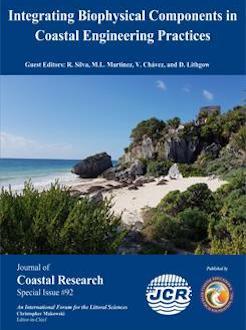Hadadpour, S.; Paul, M., and Oumeraci, H., 2019. Numerical investigation of wave attenuation by rigid vegetation based on a porous media approach. In: Silva, R.; Martínez, M.L.; Chávez, V., and Lithgow, D. (eds.), Integrating Biophysical Components in Coastal Engineering Practices. Journal of Coastal Research, Special Issue No. 92, pp. 92–100. Coconut Creek (Florida), ISSN 0749-0208.
Coastal areas are very complex and sensitive regions, which are extremely important in terms of economic, social and environmental values. Providing protection against coastal erosion is thus a significant issue and considerable research has been dedicated to the development of shore protection solutions. The importance of coastal vegetation and its role in wave attenuation and coastal protection in this context is still not fully understood. This study focuses on wave attenuation by coastal vegetation. For this purpose, numerical analysis is used to determine whether the vegetation field can be considered as a porous medium and whether a porous media based approach can be applied to describe the flow in a vegetation field. The computational fluid dynamic (CFD) solver “PorousWaveFoam” in the frame of OpenFOAM, which solves the Volume Averaged Navier–Stokes (VRANS) equations, is used for the simulation of flow in porous media. The model is calibrated and a new equivalent porosity (neq) based on leaf area index (LAI) is developed and implemented in “PorousWaveFoam”. The model is validated by various laboratory experiments of wave propagation through rigid vegetation, showing a good agreement between the measured and calculated wave height dissipation. It is concluded that the presented porous media approach performs well in simulating wave attenuation by a rigid vegetation field. Moreover, by using the validated model, it is confirmed that for a given water depth, wave attenuation depends on the plant characteristics (plant density, height and length of vegetation field). A higher density and longer vegetation field leads to higher attenuation rates. Wave attenuation decreases if the submergence ratio increases.





